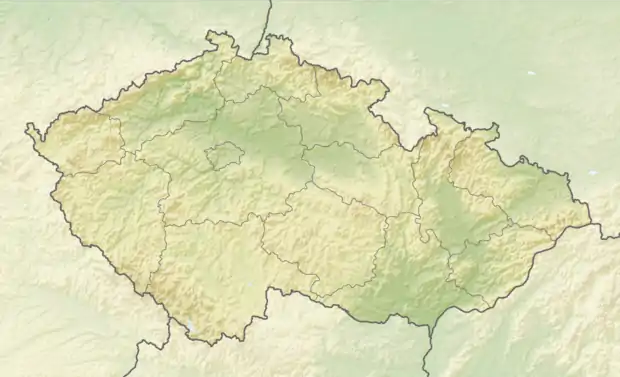Dolní Lutyně
![]() Dolní Lutyně (Polish:
Dolní Lutyně (Polish: ![]() Lutynia Dolna, German: Deutsch Leuten or Nieder Leuten) is a municipality and village in Karviná District in the Moravian-Silesian Region of the Czech Republic. It has about 5,300 inhabitants. It lies near the border with Poland, south of the Olza River, in the historical region of Cieszyn Silesia.
Lutynia Dolna, German: Deutsch Leuten or Nieder Leuten) is a municipality and village in Karviná District in the Moravian-Silesian Region of the Czech Republic. It has about 5,300 inhabitants. It lies near the border with Poland, south of the Olza River, in the historical region of Cieszyn Silesia.
Dolní Lutyně | |
|---|---|
.JPG.webp) Saint John the Baptist Church | |
 Flag  Coat of arms | |
 Dolní Lutyně Location in the Czech Republic | |
| Coordinates: 49°53′58″N 18°25′15″E | |
| Country | |
| Region | Moravian-Silesian |
| District | Karviná |
| First mentioned | 1305 |
| Municipal parts | 2
|
| Government | |
| • Mayor | Pavel Buzek |
| Area | |
| • Total | 24.88 km2 (9.61 sq mi) |
| Elevation | 202 m (663 ft) |
| Population (2020-01-01[1]) | |
| • Total | 5,312 |
| • Density | 210/km2 (550/sq mi) |
| Time zone | UTC+1 (CET) |
| • Summer (DST) | UTC+2 (CEST) |
| Postal code | 735 53 |
| Website | new |
Administrative parts
The village of Věřňovice (Wierzniowice) is an administrative part of Dolní Lutyně.
History
The village of Lutyně was first mentioned in a Latin document of Diocese of Wrocław called Liber fundationis episcopatus Vratislaviensis from around 1305 as item in Luthina LXXI) mansi.[2][3][4] It meant that the village was supposed to pay tithe from 71 greater lans. The village could have been founded by Benedictine monks from an Orlová abbey[5] and also it could a part of a larger settlement campaign taking place in the late 13th century on the territory of what will be later known as Upper Silesia.
Politically the village belonged initially to the Duchy of Teschen, formed in 1290 in the process of feudal fragmentation of Poland and was ruled by a local branch of Piast dynasty. In 1327 the duchy became a fee of Kingdom of Bohemia, which after 1526 became part of the Habsburg Monarchy.
The large village was later in the 14th century subdivided into two sister settlements. Dolní Lutyně was then known for centuries as German (Theutonicum), and the other as Polish (Polonicum), now Lutyně district of Orlová. For example, in 1450 they were together mentioned as Lutynie utrumque Theutonicum et Polonicum.[6]
German Lutynie became a seat of a Catholic parish, mentioned in the register of Peter's Pence payment from 1447 among 50 parishes of Teschen deaconry as Lutina.[7]
Since 1700 it was a property of Taafe counts who built there a baroque château as their summer residence. Object currently has no architectonical value and serves as an apartment building. At the end of the 19th century coal boom affected Cieszyn Silesia and industrialization rapidly grew. This had also impact on the village, demographically and economically.
After World War I, fall of Austria-Hungary, Polish–Czechoslovak War and the division of Cieszyn Silesia in 1920, the village became a part of Czechoslovakia. Following the Munich Agreement, in October 1938 together with the Zaolzie region it was annexed by Poland, administratively organised in Frysztat County of Silesian Voivodeship.[8] The village was then annexed by Nazi Germany at the beginning of World War II. After the war it was restored to Czechoslovakia.
The village was host to an unexploded bomb from World War II, which remained in the village until being discovered in 2014. Resultantly, 400 residents were evacuated from their homes.[9]
Notable landmarks include Catholic baroque John the Baptist church from 1746, old apothecary shop built around 1900 and the Polish school.
Environment
Part of the Olza River with its alluvium and surroundings from Dětmarovice to Bohumín (especially in Věřňovice) is an environment with fragile nature balance. In otherwise industrialized and densely populated area it is quite special, and hence is protected.
References
- "Population of Municipalities – 1 January 2020". Czech Statistical Office. 2020-04-30.
- Panic, Idzi (2010). Śląsk Cieszyński w średniowieczu (do 1528) [Cieszyn Silesia in Middle Ages (until 1528)] (in Polish). Cieszyn: Starostwo Powiatowe w Cieszynie. pp. 297–299. ISBN 978-83-926929-3-5.
- Schulte, Wilhelm (1889). Codex Diplomaticus Silesiae T.14 Liber Fundationis Episcopatus Vratislaviensis (in German). Breslau.
- "Liber fundationis episcopatus Vratislaviensis" (in Latin). Retrieved 13 July 2014.
- I. Panic, 2010, p. 430
- Mrózek, Robert (1984). Nazwy miejscowe dawnego Śląska Cieszyńskiego [Local names of former Cieszyn Silesia] (in Polish). Katowice: University of Silesia in Katowice. pp. 108–109. ISSN 0208-6336.
- "Registrum denarii sancti Petri in archidiaconatu Opoliensi sub anno domini MCCCCXLVII per dominum Nicolaum Wolff decretorum doctorem, archidiaconum Opoliensem, ex commissione reverendi in Christo patris ac domini Conradi episcopi Wratislaviensis, sedis apostolice collectoris, collecti". Zeitschrift des Vereins für Geschichte und Alterthum Schlesiens (in German). Breslau: H. Markgraf. 27: 361–372. 1893. Retrieved 21 July 2014.
- "Ustawa z dnia 27 października 1938 r. o podziale administracyjnym i tymczasowej organizacji administracji na obszarze Ziem Odzyskanych Śląska Cieszyńskiego". Dziennik Ustaw Śląskich (in Polish). Katowice. nr 18/1938, poz. 35. 31 October 1938. Retrieved 1 July 2014.
- Willoughby, Ian (1 November 2014). "Police evacuate 400 after discovery of bomb from WWII air raid in Silesian village". Radio Prague. Retrieved 15 November 2014.
- "Dolnolutyňské noviny: Přeshraniční spolupráce obcí Dolní Lutyně, Gorzyce a Godów" (PDF). dolnilutyne.org (in Czech). Obec Dolní Lutyně. November 2018. p. 3. Retrieved 2020-09-14.
- Cicha, Irena; Jaworski, Kazimierz; Ondraszek, Bronisław; Stalmach, Barbara; Stalmach, Jan (2000). Olza od pramene po ujście. Český Těšín: Region Silesia. ISBN 80-238-6081-X.

